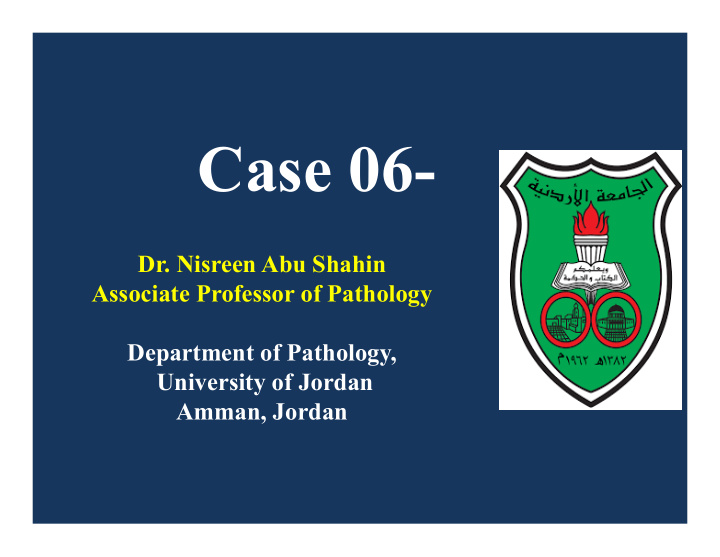



Case 06- Dr. Nisreen Abu Shahin Associate Professor of Pathology Department of Pathology, University of Jordan Amman, Jordan
Case • 24 yr old nulliparus woman, no known medical disorders, not using any medications or hormones • presents to a general physician clinic with severe menorrhagia of 2 years duration causing excessive vaginal bleeding and severe anemia • She was referred to GYN clinic for evaluation
Physical examination: • Pallor • Normal BMI • No palpated abdominal masses
Imaging • Pelvic Ultrasound. globular large uterus with multiple uterine polyps extending into cervical os, with abnormal echogenecity. • CT Scan. marked heterogeneous uterine enlargment suspicoius for adenomyosis, along with a large heterogeneous uterine polyploid mass extending to cervical os
D&C
Polypoid mass
Hyalinization
Differential diagnosis • Uterine tumors resembling ovarian sex cord tumors (UTROSCT) • Malignant mullerian mixed tumors (MMMT) • Endometrial stromal tumors • Epithelioid smooth muscle tumors • Endometrioid carcinoma with weird morphology
IHCs EMA Vimentin
Inhibin a-Inhibin
Calretinin
PAX 8
CK7
ER
CK5/6 p63
CD10 Desmin
SMA
Diagnosis?? • Designation from previous reports*: "corded and hyalinized endometrioid carcinoma" reflecting most striking and consistent features. • A phenotype of endometrioid carcinomas appreciated in recent decades * Young RH. Am J Surg Pathol. 2005 Feb;29(2):157-66
Uterus Hysterectomy was performed
Complex architecture
Squamous morules
Atypia
ACH
Adenomyosis
• Cervix: unremarkable
Differential diagnosis??? • Familial / inherited cancer syndromes ? • Ovarian tumors secreting estrogens??
• Back to patient’s family history: • Parents: consanguineous marriage • Mother died in early 40s with cancer (?multiple; ?? GIT) • A brother with GIT polyps
Ovaries
• Frozen sections were performed on right and left ovaries (Normal sized)
Right ovary
Left ovary
IHCs Inhibin EMA
• Ovarian stroma had multiple nodules showing annular tubules with central eosinophilic hyaline bodies and peripheral oriented nuclei (greatest diameter is at least 6mm of the examined frozen tissue). • Foci of calcification are identified.
Bilateral SCTAT (SEX CORD TUMOR WITH ANNULAR TUBULES)
Comments • “The presence of bilateral ovarian sex cord tumor with annular tubules is a likely source of hyper-estrogenism leading to the pathologies seen in the uterus. Moreover, the presence of the bilateral ovarian tumor raises the possibility of Peutz-Jeghers syndrome. Clinical evaluation for Peutz-Jeghers syndrome is recommended”.
• Hyperpigmented lesions over the perioral region From literature
Peutz-Jeghers syndrome (PJS) • inherited autosomal dominant cancer syndrome • tumor suppressor gene STK11/LKB1, 19p13.3 • mucocutaneous melanin pigmentation & hamartomatous GIT polyps • Incidence : 1 /50,000 to 1/ 200,000 live births • predisposition to: benign and malignant tumors of stomach, small intestine, pancreas, cervix, breast and ovaries.
The Diagnostic Criteria for PJS is Clinical • Include: • small bowel hamartomatous polyps • characteristic mucocutaneous pigmentation • family history • Two of these criteria must be met in order to make a clinical diagnosis of PJS
Cancer in PJS Banno Ee al: GYNECOLOGICAL CANCER IN PJS. Oncology Letters (2013) 6: 1184-1188.
PJS – GIT tumors • Non malignant: P-J hyperplastic polyps; ? Tubular adenomas • malignant GIT: • large intestine>> stomach> small intestine > pancreas (mucinous adenocarcinomas)
PJS- GYN tumors • highest in cervix >> ovary • ovarian, cervical and breast cancers: surveillance is necessary - Minimal deviation adenocarcinoma (MDA) - SCTAT (“ in PJS is commonly multifocal, bilateral, small (detected microscopically), and calcified in >50% of cases)”* Scully RE et al. Cancer .1982 - Mucinous and serous epithelial ovarian tumors ↑ ( benign, borderline, malignant ) • lifetime risk of endometrial CA in PJS reported ≈ 9% • 10-18 times >> general population • simultaneous multiple gynecological tumors (current case)
Current Case • Simultaneous GYN tumors? PJS germline STK11 gene mutation linked to both ? hyper-estrogenism caused by SCTAT lead to endometrial hyperplasia/ cancer ?
References 1. Cancer (1982) 50: 1384-1402. Scully RE et al. 2. Am J Pathol (2000)156: 339-345. Connolly DC et al. 3. Gynecol Oncol (2004) 92(1):337-42. Mangili G et al. 4. Am J Surg Pathol (2005) 29(2):157-66. Murray SK(1), Clement PB, Young RH. 5. Int J Gynecol Cancer (2009) 19: 1591-1594. Clements A et al. 6. Eur J Gynaecol Oncol (2011);32(4):452-4. Kondi-Pafiti A et al. 7. Onco Lett (2013); 6:1184-1188. Banno K et al. 8. Int J Clin Exp Pathol (2014);7(7):4448-4453. Zhou F et al. 9. BMC Cancer (2015) 15:270. Qian et al. 10. Zhonghua Bing Li Xue Za Zhi (2016|) 8;45(5):297-301. DOI: 10.3760/cma.j.issn.0529-5807.2016.05.003. Chinese. Sun YH et al. 11. Histol Histopathol (2009 )24(2):149-55. DOI: 10.14670/HH-24.149. Wani Y et al.
Department of Pathology, University of Jordan Amman, Jordan Thank you
Recommend
More recommend